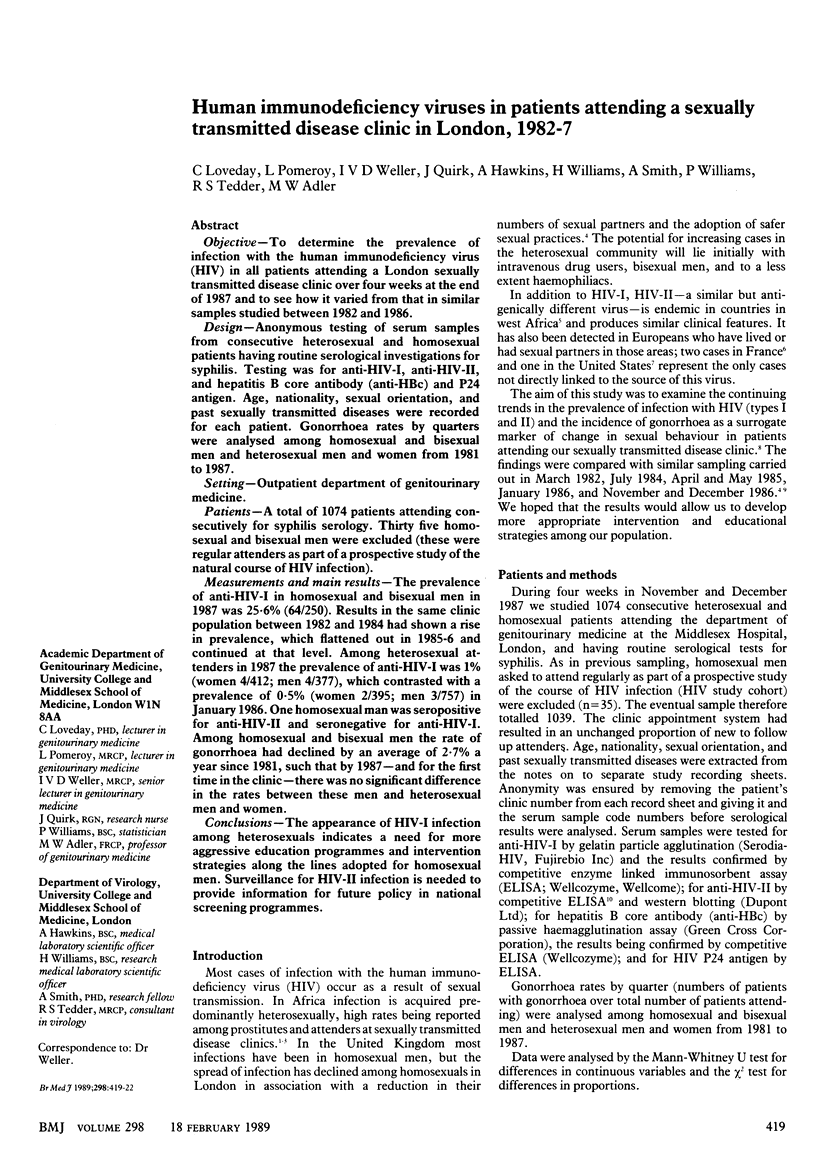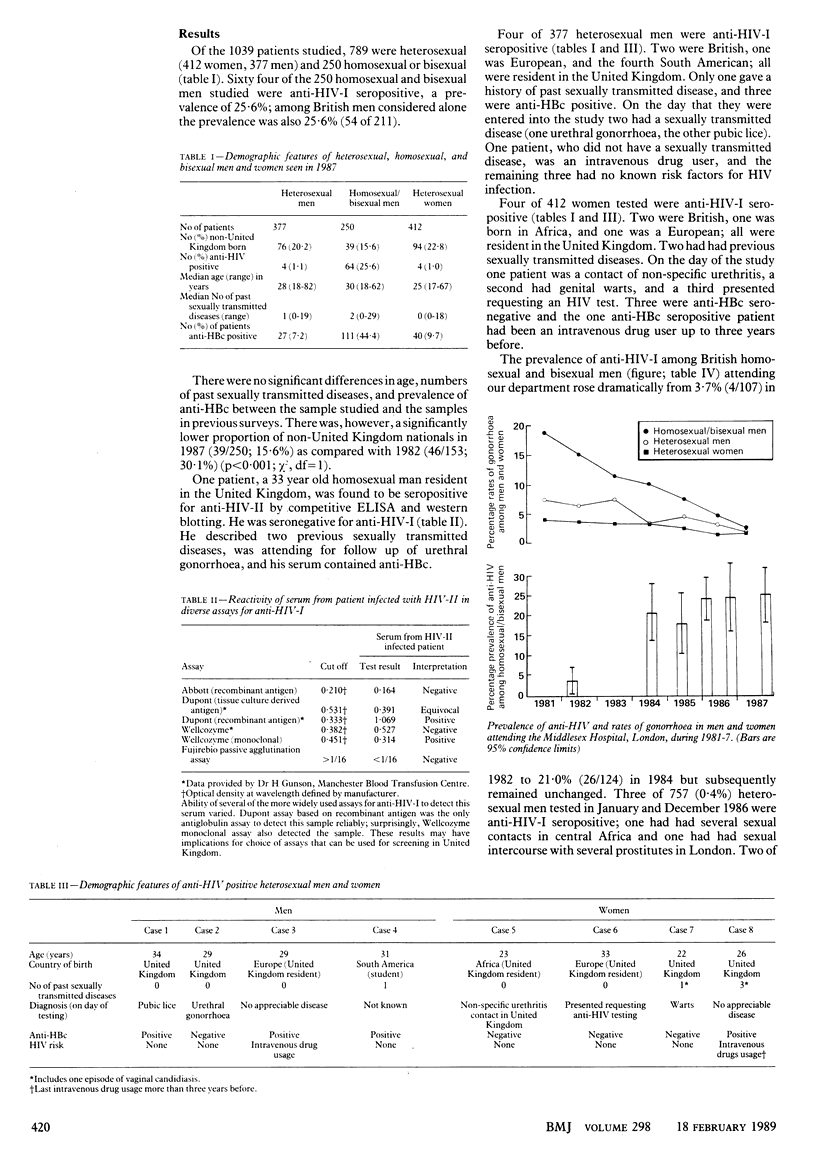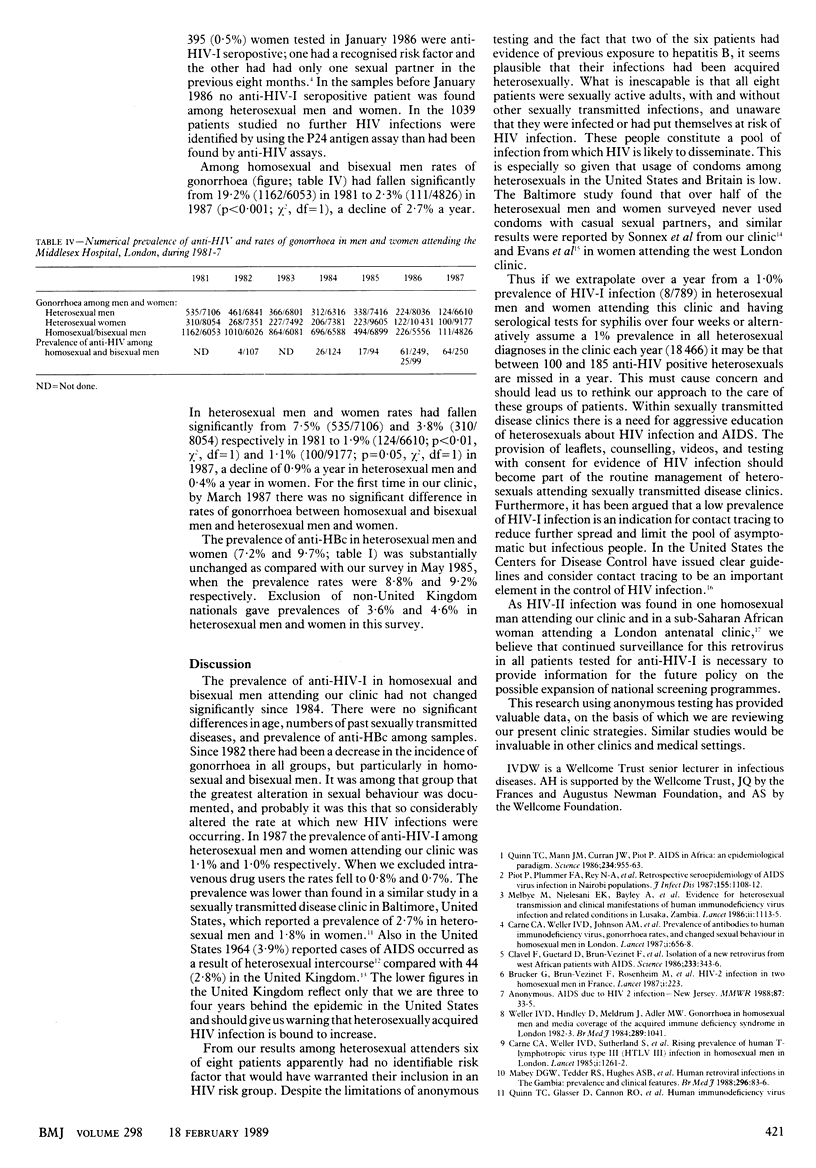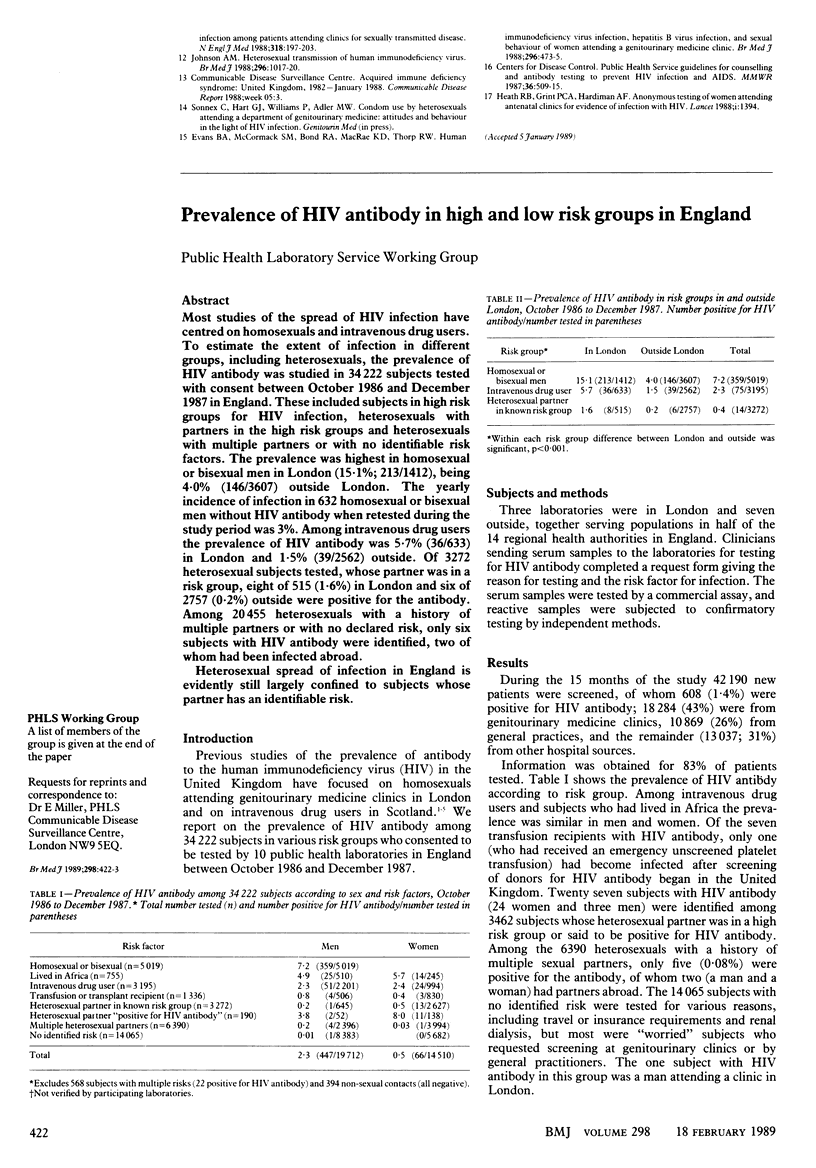Abstract
OBJECTIVE--To determine the prevalence of infection with the human immunodeficiency virus (HIV) in all patients attending a London sexually transmitted disease clinic over four weeks at the end of 1987 and to see how it varied from that in similar samples studied between 1982 and 1986. DESIGN--Anonymous testing of serum samples from consecutive heterosexual and homosexual patients having routine serological investigations for syphilis. Testing was for anti-HIV-I, anti-HIV-II, and hepatitis B core antibody (anti-HBc) and P24 antigen. Age, nationality, sexual orientation, and past sexually transmitted diseases were recorded for each patient. Gonorrhoea rates by quarters were analysed among homosexual and bisexual men and heterosexual men and women from 1981 to 1987. SETTING--Outpatient department of genitourinary medicine. PATIENTS--A total of 1074 patients attending consecutively for syphilis serology. Thirty five homosexual and bisexual men were excluded (these were regular attenders as part of a prospective study of the natural course of HIV infection). MEASUREMENTS AND MAIN RESULTS--The prevalence of anti-HIV-I in homosexual and bisexual men in 1987 was 25.6% (64/250). Results in the same clinic population between 1982 and 1984 had shown a rise in prevalence, which flattened out in 1985-6 and continued at that level. Among heterosexual attenders in 1987 the prevalence of anti-HIV-I was 1% (women 4/412; men 4/377), which contrasted with a prevalence of 0.5% (women 2/395; men 3/757) in January 1986. One homosexual man was seropositive for anti-HIV-II and seronegative for anti-HIV-I. Among homosexual and bisexual men the rate of gonorrhoea had declined by an average of 2.7% a year since 1981, such that by 1987--and for the first time in the clinic--there was no significant difference in the rates between these men and heterosexual men and women. CONCLUSIONS--The appearance of HIV-I infection among heterosexuals indicates a need for more aggressive education programmes and intervention strategies along the lines adopted for homosexual men. Surveillance for HIV-II infection is needed to provide information for future policy in national screening programmes.
Full text
PDF



Selected References
These references are in PubMed. This may not be the complete list of references from this article.
- Brücker G., Brun-Vezinet F., Rosenheim M., Rey M. A., Katlama C., Gentilini M. HIV-2 infection in two homosexual men in France. Lancet. 1987 Jan 24;1(8526):223–223. doi: 10.1016/s0140-6736(87)90043-2. [DOI] [PubMed] [Google Scholar]
- Carne C. A., Weller I. V., Johnson A. M., Loveday C., Pearce F., Hawkins A., Smith A., Williams P., Tedder R. S., Adler M. W. Prevalence of antibodies to human immunodeficiency virus, gonorrhoea rates, and changed sexual behaviour in homosexual men in London. Lancet. 1987 Mar 21;1(8534):656–658. doi: 10.1016/s0140-6736(87)90415-6. [DOI] [PubMed] [Google Scholar]
- Carne C. A., Weller I. V., Sutherland S., Cheingsong-Popov R., Ferns R. B., Williams P., Mindel A., Tedder R., Adler M. W. Rising prevalence of human T-lymphotropic virus type III (HTLV-III) infection in homosexual men in London. Lancet. 1985 Jun 1;1(8440):1261–1262. doi: 10.1016/s0140-6736(85)92324-4. [DOI] [PubMed] [Google Scholar]
- Centers for Disease Control (CDC) Public Health Service guidelines for counseling and antibody testing to prevent HIV infection and AIDS. MMWR Morb Mortal Wkly Rep. 1987 Aug 14;36(31):509–515. [PubMed] [Google Scholar]
- Clavel F., Guétard D., Brun-Vézinet F., Chamaret S., Rey M. A., Santos-Ferreira M. O., Laurent A. G., Dauguet C., Katlama C., Rouzioux C. Isolation of a new human retrovirus from West African patients with AIDS. Science. 1986 Jul 18;233(4761):343–346. doi: 10.1126/science.2425430. [DOI] [PubMed] [Google Scholar]
- Evans B. A., McCormack S. M., Bond R. A., MacRae K. D., Thorp R. W. Human immunodeficiency virus infection, hepatitis B virus infection, and sexual behaviour of women attending a genitourinary medicine clinic. Br Med J (Clin Res Ed) 1988 Feb 13;296(6620):473–475. doi: 10.1136/bmj.296.6620.473. [DOI] [PMC free article] [PubMed] [Google Scholar]
- Heath R. B., Grint P. C., Hardiman A. E. Anonymous testing of women attending antenatal clinics for evidence of infection with HIV. Lancet. 1988 Jun 18;1(8599):1394–1394. doi: 10.1016/s0140-6736(88)92203-9. [DOI] [PubMed] [Google Scholar]
- Johnson A. M. Heterosexual transmission of human immunodeficiency virus. Br Med J (Clin Res Ed) 1988 Apr 9;296(6628):1017–1020. doi: 10.1136/bmj.296.6628.1017. [DOI] [PMC free article] [PubMed] [Google Scholar]
- Mabey D. C., Tedder R. S., Hughes A. S., Corrah P. T., Goodison S. J., O'Connor T., Shenton F. C., Lucas S. B., Whittle H. C., Greenwood B. M. Human retroviral infections in The Gambia: prevalence and clinical features. Br Med J (Clin Res Ed) 1988 Jan 9;296(6615):83–86. doi: 10.1136/bmj.296.6615.83. [DOI] [PMC free article] [PubMed] [Google Scholar]
- Piot P., Plummer F. A., Rey M. A., Ngugi E. N., Rouzioux C., Ndinya-Achola J. O., Veracauteren G., D'Costa L. J., Laga M., Nsanze H. Retrospective seroepidemiology of AIDS virus infection in Nairobi populations. J Infect Dis. 1987 Jun;155(6):1108–1112. doi: 10.1093/infdis/155.6.1108. [DOI] [PubMed] [Google Scholar]
- Quinn T. C., Glasser D., Cannon R. O., Matuszak D. L., Dunning R. W., Kline R. L., Campbell C. H., Israel E., Fauci A. S., Hook E. W., 3rd Human immunodeficiency virus infection among patients attending clinics for sexually transmitted diseases. N Engl J Med. 1988 Jan 28;318(4):197–203. doi: 10.1056/NEJM198801283180401. [DOI] [PubMed] [Google Scholar]
- Quinn T. C., Mann J. M., Curran J. W., Piot P. AIDS in Africa: an epidemiologic paradigm. Science. 1986 Nov 21;234(4779):955–963. doi: 10.1126/science.3022379. [DOI] [PubMed] [Google Scholar]
- Weller I. V., Hindley D. J., Adler M. W., Meldrum J. T. Gonorrhoea in homosexual men and media coverage of the acquired immune deficiency syndrome in London 1982-3. Br Med J (Clin Res Ed) 1984 Oct 20;289(6451):1041–1041. doi: 10.1136/bmj.289.6451.1041. [DOI] [PMC free article] [PubMed] [Google Scholar]


